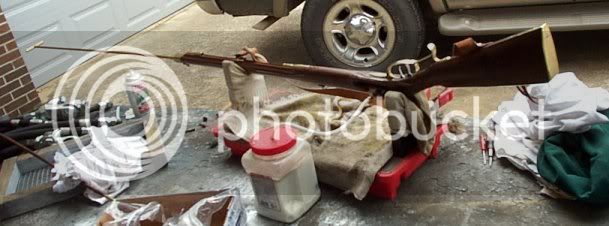Everyone seems to be different here, so here's mine.
Most all my guns are pinned. On first cleaning I remove the barrel. Clean out all oils and wax the tar out of the wood and barrel. Plug the vent pour in scalding hot water and let set a few minutes, Dump and refill (want it HOT!). Add anouther (very)heavy layer of wax in the barrel channel, Melt as much onto the bottom and sides of the barrel as I can get to stay. Drain barrel and quickly dry (keeping it hot) and reinstall to stock. Now I wax the tar out of all metal to wood seams (quickly while still hot and with the wife's hair dryer I try to get as much wax into the joints as possible. Let cool. Wax up everything (brass trim and all) and hand buff. (hint; a small 2" pc. of rag used with dried walnut stain is a blessing on a walnut stock). Usually do this 3-4 times before next use. This seals the barrel and wood pretty darn good, just wax it once in awhile to maintain seal. (lock & mortice is the only thing not waxed but mortice is)
Also make a breach scraper filed to conform to the breach with near 100% contact, drill and slot the end near the disc end to accept a rag.
With lock installed, my guns are now "prepped for usage".
After a day of shooting, I swab the barrel (at the range) with windex to remove most of the heavier fowling and I run a swab of Bore Butter down her and head for home (usually with a stop or two along the way).
At home (real clean-up);
Sharpen flint (if req'd)and remove, remove lock and set in HOT water. Run scraper to breach twist a few times and remove. Plug vent, wrap towel and tape around muzzle, fill with HOT water, Get a beer and open

eace:. after a couple of minutes dump water, and fill 1/2 way with more hot water and work a bronze brush, dump and repeat until clean. On the end of the scraper add a rag (I use a 5" strip for a .75, 2 1/2 for .45, etc.) and wet with HOT water, start rag into bore and push to breach and twist, repeat til clean, Wet pipe cleaner in flash hole and clean surrounding area, Replug and fill again with hot water to get barrel really hot (have a slug of brew while heating

). Dump, swab with scraper, and jag til dry (but still hot) and clean, follow with jag and 90% alchohol, Swab with Bore Butter (still too hot to hold) with scraper and rag don't forget the breach end.
With tooth brush and flux brush clean the lock and flint, More hot water to heat lock, dry, cool, oil, when all is cool, reassenble and pipe clean vent (again to be sure the BB did't plug it).
If you think it needs it, wax again, if not, just wipe it down and finish your brew.
When you get the routine down you can be done with everything (except the brew :results

in 20-30 minutes.
After about an hour or so, I'll sometimes plug the vent and cork the bore if I'm going to store them for any time. If not used, I'll reswab the bores every couple of months with BB. I've never had any rust problems with this method and I live in New England where humidity is often around 90%. "Sealing" IS the key to rust prevention. :thumbsup:
I'm not saying this is the best or only way, just that "it works for me". :front:






